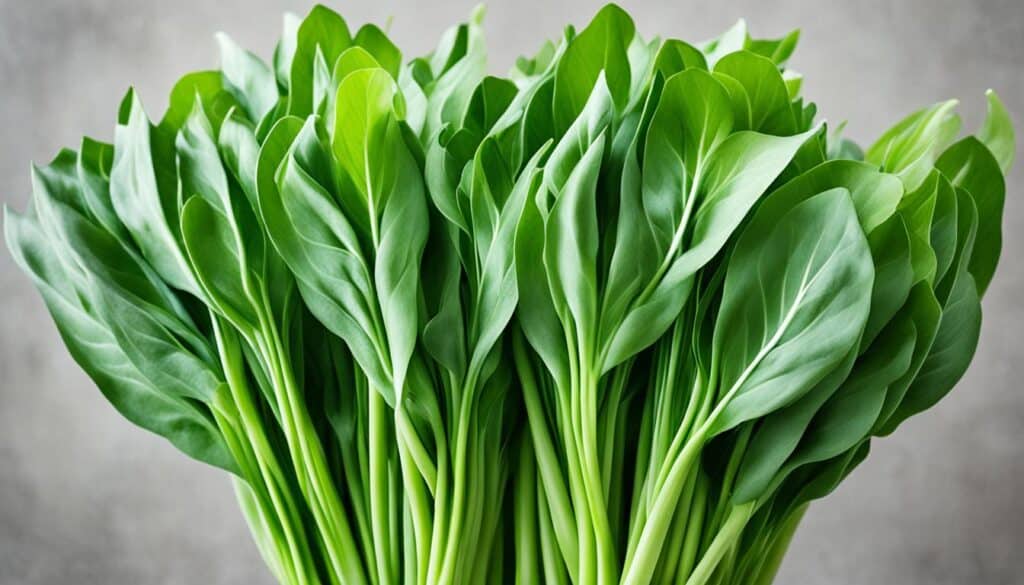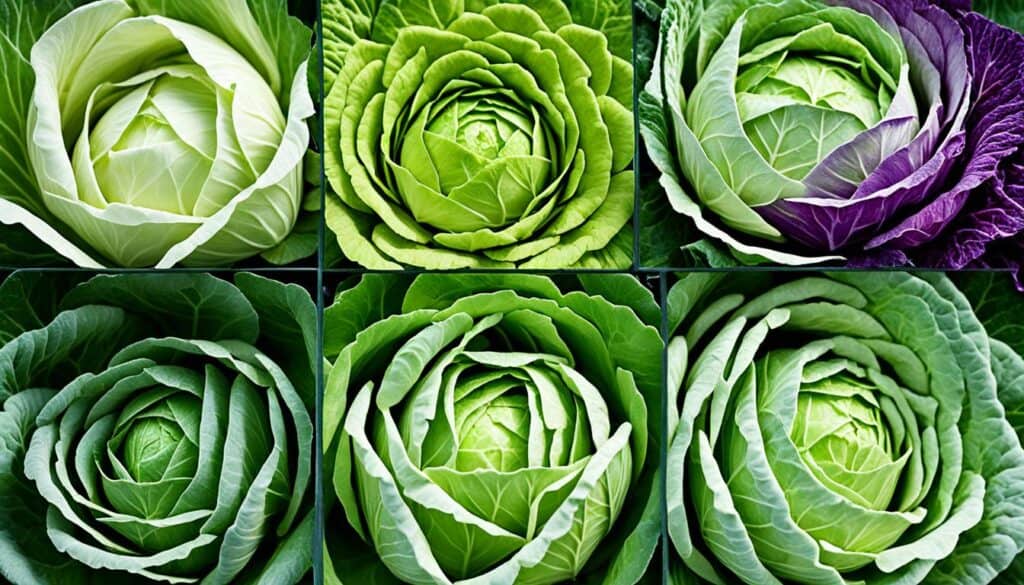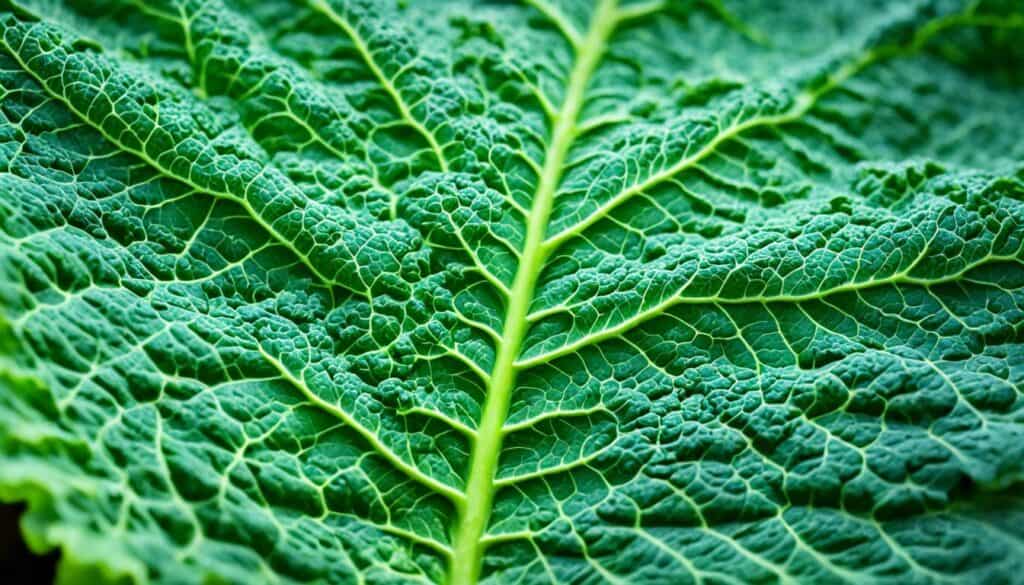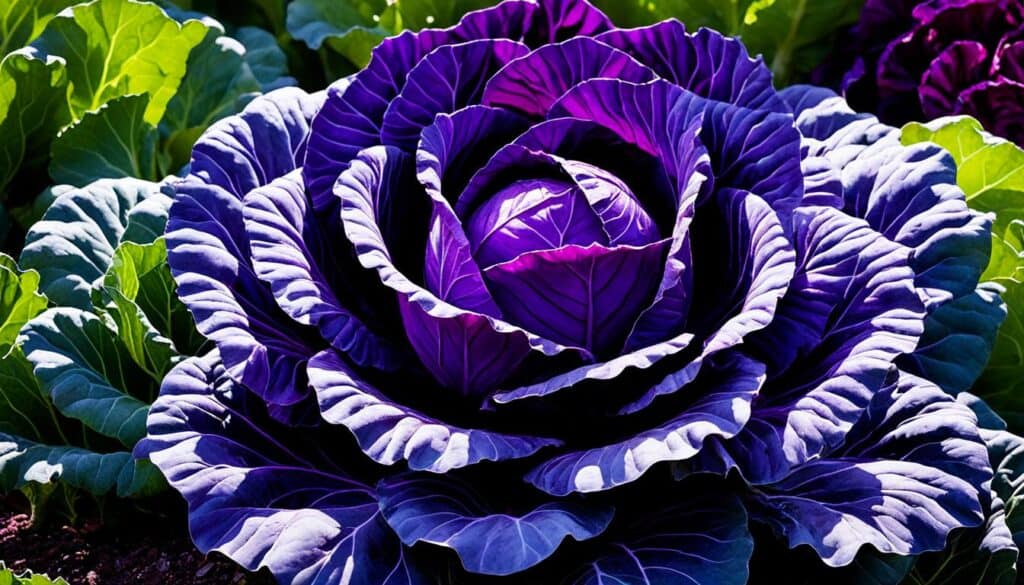Did you know that there are over 400 varieties of cabbage? Yes, you read that right! This humble vegetable comes in a wide range of types and varieties, each with its own unique characteristics and flavors. From the familiar green cabbage to the vibrant red cabbage and the delicate bok choy, cabbage offers a world of culinary possibilities. Whether you’re a seasoned gardener or a home cook looking to explore new flavors, this guide will take you on a journey through the diverse world of cabbage.
Key Takeaways:
- Cabbage comes in over 400 varieties, offering a wide range of flavors and characteristics.
- Some common types of cabbage include green cabbage, red cabbage, bok choy, Napa cabbage, Savoy cabbage, and January King cabbage.
- Each variety of cabbage has its own unique culinary uses, from salads and stir-fries to braising and fermenting.
- Exploring different types of cabbage can add variety and nutritional benefits to your meals.
- Growing cabbage in your own vegetable garden can be a rewarding experience.
Common Cabbage Varieties
When it comes to cabbage, there are several popular types and varieties to choose from. Each variety has its own unique flavor and appearance, making it suitable for different culinary uses. Let’s take a closer look at some common cabbage varieties:
- Green Cabbage: Green cabbage, also known as Cannonball cabbage, is the most well-known and widely used variety. It has tightly wound leaves that form a dense, compact head. Green cabbage is versatile and can be used in a variety of cooking methods, such as braising, stewing, or boiling. It is the perfect choice for classic dishes like coleslaw and sauerkraut.
- Red Cabbage: Known for its vibrant purple color, red cabbage adds a beautiful pop of color to dishes. It has a slightly peppery taste and a crisp texture. Red cabbage is commonly used in salads, slaws, braised dishes, and even fermented into sauerkraut.
- Savoy Cabbage: Savoy cabbage is easily recognizable by its crinkled, lacy leaves. It has a milder flavor compared to other varieties and a delicate texture. Savoy cabbage is often used in soups, stews, stir-fries, and stuffed cabbage rolls.
- Napa Cabbage: Napa cabbage, also known as Chinese cabbage, has long, oblong-shaped leaves that are crinkled near the edges. It has a mild, slightly sweet flavor and a tender texture. Napa cabbage is commonly used in Asian cuisine, particularly in dishes like kimchi, stir-fries, and salads.
- January King Cabbage: January King cabbage is a winter variety that features beautiful purple and green leaves. It has a sweet, nutty flavor and a firm texture. This cabbage variety is perfect for roasting, as the leaves hold up well to heat and develop a delicious caramelized flavor.
These are just a few examples of the common cabbage varieties out there. Each type of cabbage brings its own unique characteristics to the table, allowing you to experiment and create a diverse range of dishes.
“Cabbage is a versatile and nutritious vegetable that comes in various types and varieties. From green cabbage to January King cabbage, each variety has its own unique flavor and culinary uses.”
Green Cabbage (Cannonball Cabbage)
When it comes to cabbage, one variety that stands out is green cabbage, also known as Cannonball cabbage. As one of the most popular types of cabbage, it is beloved by both gardeners and cooks for its versatility and culinary uses. Green cabbage is characterized by tightly wound leaves that form a dense, compact head, making it an ideal choice for a variety of cooking methods.
Whether you’re braising, stewing, or boiling, green cabbage holds up well and retains its delicious flavor. Its robust leaves are perfect for absorbing the flavors of the accompanying ingredients, resulting in hearty and satisfying dishes. The dense nature of Cannonball cabbage makes it an excellent choice for shredding or chopping, allowing for easy incorporation into salads, coleslaws, or stir-fries.
Benefits of Green Cabbage
- Nutritional Powerhouse: Green cabbage is packed with essential nutrients such as vitamins C and K, fiber, and antioxidants, making it a smart choice for a healthy diet.
- Versatile Cooking Ingredient: From stuffed cabbage rolls to sautéed cabbage side dishes, green cabbage can be used in a variety of dishes to add a delicious and nutritious touch.
- Long Storage Life: When stored properly in a cool, dry place, green cabbage can last for several weeks, providing a reliable source of fresh produce in your kitchen.
“I love using green cabbage in my cooking because of its sturdy texture and mild flavor. It adds the perfect crunch to salads and works wonders when braised or stir-fried.” – Jane, Home Cook
No matter how you choose to use it, green cabbage is a fantastic addition to any kitchen. Its versatility and nutritional benefits make it a staple ingredient for a variety of cooking styles and cuisines. Whether you’re an experienced chef or a novice in the kitchen, green cabbage is sure to elevate your dishes with its delightful taste and satisfying texture.
Bok Choy
When it comes to salads, bok choy is a fantastic choice. This leafy vegetable with its slender stems adds a delightful crunch and refreshing taste to any salad. Its mild flavor pairs well with a variety of dressings, making it a versatile ingredient.
Bok choy is a staple in Asian cuisine, known for its delicate and slightly sweeter taste compared to other cabbage varieties. It is commonly used in salads, providing a unique texture and visual appeal. The vibrant green leaves and crisp stems of bok choy are not only visually appealing but also packed with nutrients.
Aside from salads, bok choy is also often stir-fried with garlic and oyster sauce, enhancing its flavor while still retaining its crispiness. The combination of bok choy’s fresh taste and the umami flavors from the sauce creates a harmonious blend that can elevate any stir-fry dish.
Include bok choy in your next salad creation or stir-fry dish, and enjoy its unique flavor and texture. Its versatility and nutritional benefits make it an excellent addition to any meal.
Choy Sum
Choy Sum, also known as Cai Xin, is a leafy vegetable similar to bok choy. With its mild flavor and tender texture, Choy Sum is a versatile ingredient that can be used in various culinary preparations. Whether you’re looking to add some greenery to your salads or enhance the flavors of your cooking, Choy Sum is a fantastic choice.
One popular way to enjoy Choy Sum is by blanching it. Simply boil a pot of water and submerge the Choy Sum for a minute or two until it turns bright green. Then, drain the Choy Sum and transfer it to a bowl of ice water to stop the cooking process. This blanched Choy Sum can be used to add a refreshing crunch to salads or incorporated into delicious dumplings, noodles, or soups.
Aside from its versatility in salads, Choy Sum can also be cooked alongside other ingredients for a delightful blend of flavors. Stir-frying Choy Sum with garlic and a splash of soy sauce creates a savory and aromatic side dish that pairs well with various proteins. Its mild flavor allows the other ingredients to shine while adding a touch of freshness to the overall dish.
“Choy Sum provides a delicate and slightly bitter taste that complements a range of dishes. Its tender leaves and stalks add a textural element that elevates the overall eating experience.”
To incorporate Choy Sum into your cooking, consider trying out this simple recipe:
| Stir-Fried Choy Sum with Garlic |
|---|
| Ingredients: |
|
| Instructions: |
|
With its versatility and mild flavor, Choy Sum is a fantastic addition to any kitchen. Whether you’re looking to enhance the taste of your salads or experiment with new flavors in your cooking, Choy Sum offers a delightful and nutritious option.
Napa Cabbage
When it comes to cabbage types for cooking and salads, Napa cabbage is a popular choice in East Asian cuisine. With its oblong shape and frilly, yellow-green leaves, Napa cabbage adds a unique texture and flavor to dishes.
This versatile cabbage variety is most commonly used in kimchi, a traditional Korean dish known for its spicy and tangy flavors. The crisp and slightly sweet taste of Napa cabbage complements the other ingredients in kimchi, making it a staple in Korean cuisine.
“Napa cabbage is the secret ingredient in a perfect bowl of kimchi. Its crunch and juiciness add a delightful element to the dish.”
Aside from kimchi, Napa cabbage can also be enjoyed in salads or stir-fried dishes. Its tender yet sturdy leaves make it ideal for raw preparations, allowing you to create refreshing salads that burst with freshness. You can also lightly sauté or stir-fry Napa cabbage to retain its crispness while adding a hint of cooked flavor.
To showcase the versatility of Napa cabbage in both cooking and salads, here is a comparison table highlighting its characteristics:
| Usage | Cooking | Salads |
|---|---|---|
| Taste | Slightly sweet and mild | Refreshing and crisp |
| Texture | Tender, yet holds its shape well when cooked | Crunchy and juicy |
| Preparation | Braising, stir-frying, or boiling | Raw in salads, lightly sautéed |
| Popular Dishes | Kimchi, stir-fried Napa cabbage | Napa cabbage salad, coleslaw |
Whether you’re exploring the world of Asian cuisine or looking to add a unique twist to your salads, Napa cabbage is a fantastic choice. Its distinctive appearance, delicate texture, and versatile nature make it a valuable addition to your culinary repertoire.
Savoy Cabbage
Savoy cabbage is a delightful variety known for its unique appearance and delicate flavor. Its lacy, loosely layered leaves set it apart from other cabbage varieties, giving it a distinctive charm. The leaves of Savoy cabbage are more tender compared to other types, making it a versatile choice both in raw and cooked preparations.
One of the popular ways to enjoy Savoy cabbage is by using it as a wrap for fillings. Its pliable leaves provide a lovely texture and a mild cabbage flavor that complements a wide range of ingredients. Whether you fill it with savory meats and vegetables or opt for a vegetarian filling, Savoy cabbage wraps add an element of freshness and crunch to any dish.
Beyond being a delicious wrap, Savoy cabbage excels in braised dishes. With its tender leaves and delicate flavor, it lends itself well to slow cooking in butter and stock. The result is a comforting and flavorful dish that showcases the natural sweetness of the cabbage.
To better understand the unique qualities of Savoy cabbage, let’s take a closer look at its characteristics in the table below:
| Characteristic | Description |
|---|---|
| Leaf Appearance | Lacy and loosely layered |
| Texture | Tender |
| Flavor | Mild and delicate |
| Uses | Wraps, braised dishes |
Savoy cabbage offers a unique culinary experience with its lacy leaves and delicate flavor. Its versatility in raw and cooked dishes makes it a favorite among cabbage enthusiasts. Whether you choose to use it as a wrap or braise it in butter and stock, Savoy cabbage is sure to add a touch of elegance to your meals.
January King Cabbage
The January King cabbage is a robust and visually striking vegetable with vibrant purple-green leaves. This unique cabbage variety offers a range of captivating colors, from deep purples to crisp turquoises, making it a delightful addition to any garden or meal.
With its hardy nature, the January King cabbage thrives in colder climates, making it a suitable option for gardeners in various regions. This hardy cabbage plant is known for its ability to withstand frost and continue to grow even during the winter months.
The January King cabbage is not only visually appealing but also offers a delicious taste profile. Its leaves have a subtle sweetness and a slightly peppery flavor, making it an excellent choice for cooking.
One popular cooking method for the January King cabbage is roasting. By roasting this cabbage variety with butter, seasoning, and spices, you can enhance its natural flavors and create a mouthwatering side dish that is both hearty and nutritious.
The versatility of the January King cabbage extends beyond roasting. It can also be added to stir-fries, soups, and stews for added texture and flavor. The firm leaves of the January King cabbage hold up well during cooking, and its unique color adds a visual appeal to any dish.
Whether you’re an experienced gardener looking to add some excitement to your vegetable garden or a cooking enthusiast searching for a new ingredient to elevate your dishes, the January King cabbage is a fantastic choice. Its hardy nature, striking appearance, and flavorful taste make it a standout variety among cabbage plants.
Red Cabbage
Red cabbage, also known as purple cabbage or red kraut, is a versatile cabbage variety with beautiful reddish or purplish leaves. This vibrant color adds visual appeal to any dish.
What makes red cabbage unique is its ability to change color based on the pH value of the soil it grows in. In acidic soil, the leaves turn a rich purple, while alkaline soil produces a more red hue.
Red cabbage is a popular choice for salads due to its eye-catching color and crisp texture. Its slightly peppery and earthy flavor adds a delightful twist to any fresh salad combination.
This cabbage variety is also commonly used in braised dishes, such as hearty stews and slow-cooked recipes. When cooked, the leaves soften and develop a sweet, subtle taste that complements savory flavors.
Furthermore, red cabbage can be fermented into sauerkraut, a traditional dish. The fermentation process not only enhances its tangy flavor but also creates a probiotic-rich side that offers numerous health benefits.
“Red cabbage adds a vibrant pop of color to salads and brings a unique flavor to braised dishes. It’s a versatile cabbage variety that can be enjoyed in various culinary creations.” – [Culinary Expert]
Conclusion
Cabbage is truly a vegetable of incredible variety and versatility. With different types and varieties to choose from, there is a cabbage for every gardener and cook. From the classic green cabbage with its tightly packed leaves, to the delicate and leafy bok choy, each cabbage type has its own unique characteristics to offer.
Whether you’re looking to add crunch to your salads or create hearty braised dishes, the different cabbage types provide an array of culinary possibilities. Napa cabbage, with its oblong shape and frilly leaves, is perfect for adding a fresh crunch to salads or for stir-frying in Asian-inspired dishes. Savoy cabbage, with its lacy and tender leaves, can be enjoyed both raw and cooked, making it a versatile choice for wraps or braising.
Red cabbage, with its beautiful purplish leaves, adds vibrant color and a slightly tangy flavor to salads and braised dishes. And who can forget the Cannonball cabbage, also known as green cabbage, which is perfect for traditional cooking methods like stewing, boiling, or braising.
So, whether you’re a gardener looking to expand your vegetable patch or a home cook wanting to explore new flavors, the world of cabbage types and varieties is waiting for you. Get creative with your culinary creations and discover the wonders of cabbage in all its forms!










Leave a Reply